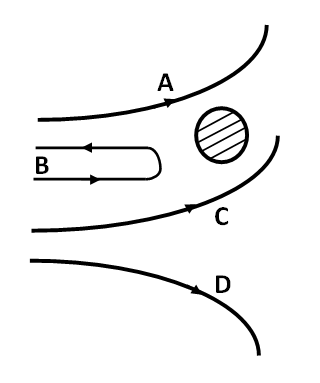
In the Rutherford experiment, \[\alpha - \] particles are scattered from a nucleus as shown. Out of the four paths, which path is not possible?

A. D
B. B
C. C
D. A
Answer
218.1k+ views
Hint: To answer this question, one must know Rutherford’s experiment details and the structure of Rutherford’s model of an atom. The dispersion of \[\alpha - \] particles in Rutherford's experiment revealed for the first time that the atom has a nucleus. He noticed that the positive charges in the atom repelled and deflected the positively charged \[\alpha - \] particles. This positively charged area of the atom was given the term "nucleus" by Rutherford.
Complete step by step solution:
We know that like charges repel whereas unlike charges attract. Using this concept along with the knowledge of Rutherford’s model of an atom, we will get the required answer. The structure of alpha particles, also known as alpha rays or alpha radiation, is similar to that of the helium-4 nucleus and is made up of two protons and two neutrons bonded together. They are often formed during the alpha decay process, although they can also be produced by other processes.
The \[\alpha - \] particles carry $ + 2e$ charge on them ( $e$ is the charge of a single electron/proton). Also, the nucleus carries a charge of $ + Ze$ where $Z$ is the atomic number of the atom. Both these particles carry positive charge therefore, the electrostatic force between them is repulsive in nature.
In path D., the \[\alpha - \] particle is going away from the nucleus due to repulsion. Therefore, path D. is possible. In path B., the \[\alpha - \] particle is bouncing back due to repulsion, therefore, this path is also possible.Similarly, in path A., the \[\alpha - \] particle gets repelled by the nucleus and goes away from it. Hence, path A. is also possible.
Whereas in path C. the distance between the \[\alpha - \] particle and the nucleus is decreasing which implies that the \[\alpha - \] particle and the nucleus are attracting each other, which is not true. Therefore, path C. is not possible.
Hence, option C is the answer.
Note: An atom's positive charge and the majority of its mass are concentrated in its tiny nucleus, which serves to resist any incoming positive charges. According to Rutherford's theory, an atom's nucleus is surrounded by electrons that are negatively charged. He also asserted that the electrons that surround the nucleus travel in a circular pattern at extremely high speeds. He gave these elliptical routes the name orbits.
Complete step by step solution:
We know that like charges repel whereas unlike charges attract. Using this concept along with the knowledge of Rutherford’s model of an atom, we will get the required answer. The structure of alpha particles, also known as alpha rays or alpha radiation, is similar to that of the helium-4 nucleus and is made up of two protons and two neutrons bonded together. They are often formed during the alpha decay process, although they can also be produced by other processes.
The \[\alpha - \] particles carry $ + 2e$ charge on them ( $e$ is the charge of a single electron/proton). Also, the nucleus carries a charge of $ + Ze$ where $Z$ is the atomic number of the atom. Both these particles carry positive charge therefore, the electrostatic force between them is repulsive in nature.
In path D., the \[\alpha - \] particle is going away from the nucleus due to repulsion. Therefore, path D. is possible. In path B., the \[\alpha - \] particle is bouncing back due to repulsion, therefore, this path is also possible.Similarly, in path A., the \[\alpha - \] particle gets repelled by the nucleus and goes away from it. Hence, path A. is also possible.
Whereas in path C. the distance between the \[\alpha - \] particle and the nucleus is decreasing which implies that the \[\alpha - \] particle and the nucleus are attracting each other, which is not true. Therefore, path C. is not possible.
Hence, option C is the answer.
Note: An atom's positive charge and the majority of its mass are concentrated in its tiny nucleus, which serves to resist any incoming positive charges. According to Rutherford's theory, an atom's nucleus is surrounded by electrons that are negatively charged. He also asserted that the electrons that surround the nucleus travel in a circular pattern at extremely high speeds. He gave these elliptical routes the name orbits.
Recently Updated Pages
Arithmetic, Geometric & Harmonic Progressions Explained

Cartesian Form of Vector Explained: Formula, Examples & Uses

Apparent Frequency Explained: Formula, Uses & Examples

Calorimetry: Definition, Principles & Calculations

Centrifugal Force Explained: Definition, Formula & Examples

Charge in a Magnetic Field: Definition, Formula & Examples

Trending doubts
JEE Main 2026: Application Form Open, Exam Dates, Syllabus, Eligibility & Question Papers

Derivation of Equation of Trajectory Explained for Students

Hybridisation in Chemistry – Concept, Types & Applications

Understanding the Angle of Deviation in a Prism

Understanding Collisions: Types and Examples for Students

Understanding Atomic Structure for Beginners

Other Pages
JEE Advanced Marks vs Ranks 2025: Understanding Category-wise Qualifying Marks and Previous Year Cut-offs

How to Convert a Galvanometer into an Ammeter or Voltmeter

Ideal and Non-Ideal Solutions Explained for Class 12 Chemistry

Degree of Dissociation: Meaning, Formula, Calculation & Uses

Understanding Electromagnetic Waves and Their Importance

Understanding Average and RMS Value in Electrical Circuits




